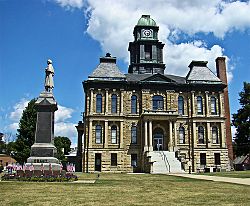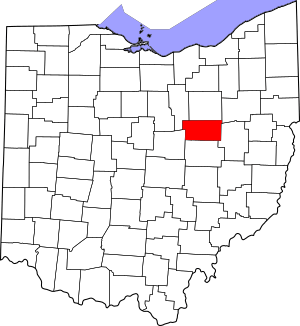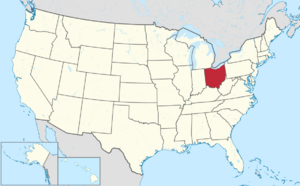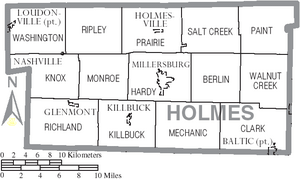Holmes County, Ohio facts for kids
Quick facts for kids
Holmes County
|
||
|---|---|---|

Holmes County Courthouse, with the Grant Memorial Statue
|
||
|
||

Location within the U.S. state of Ohio
|
||
 Ohio's location within the U.S. |
||
| Country | ||
| State | ||
| Founded | January 4, 1825 | |
| Named for | Andrew Holmes | |
| Seat | Millersburg | |
| Largest village | Millersburg | |
| Area | ||
| • Total | 424 sq mi (1,100 km2) | |
| • Land | 423 sq mi (1,100 km2) | |
| • Water | 1.4 sq mi (4 km2) 0.3%% | |
| Population
(2020)
|
||
| • Total | 44,223 | |
| • Estimate
(2021)
|
44,271 | |
| • Density | 104.30/sq mi (40.27/km2) | |
| Time zone | UTC−5 (Eastern) | |
| • Summer (DST) | UTC−4 (EDT) | |
| Congressional district | 7th | |
Holmes County is a county located in the U.S. state of Ohio. As of the 2020 census, the population was 44,223. Its county seat is Millersburg. The county was formed in 1824 from portions of Coshocton, Tuscarawas and Wayne counties and organized the following year. It was named after Andrew Holmes, an officer killed in the War of 1812.
Holmes County, which was about 42% Amish in 2010, and 48% in 2020, has the highest concentration of Amish in the world, which draws many visitors to the county. The Holmes Amish settlement (which also includes amish from the neighbouring counties, such as: Wayne, Coshocton, Tuscarawas and Stark) is the second biggest one in the world (after the Lancaster County, Pennsylvania) and numbered 37,770 people in 2021.
Contents
History
Holmes County was formed on January 20, 1824 from portions of Coshocton, Tuscarawas and Wayne counties. It was named after Andrew Holmes, an officer in the War of 1812. During the Civil War, small-scale riots broke out in ethnic German areas. Holmes County was an isolated localistic area dominated by Pennsylvania Dutch and some recent German immigrants. It was a Democratic stronghold and few men dared speak out in favor of conscription. Local politicians denounced Lincoln and Congress as despotic, seeing the draft law as a violation of their local autonomy. In June 1863, small scale disturbances broke out; they ended when the Army sent in armed units.
Geography
According to the U.S. Census Bureau, the county has a total area of 424 square miles (1,100 km2), of which 423 square miles (1,100 km2) is land and 1.4 square miles (3.6 km2) (0.3%) is water.
Adjacent counties
- Wayne County (north)
- Stark County (northeast)
- Tuscarawas County (east)
- Coshocton County (south)
- Knox County (southwest)
- Ashland County (northwest)
Demographics
| Historical population | |||
|---|---|---|---|
| Census | Pop. | %± | |
| 1830 | 9,135 | — | |
| 1840 | 18,088 | 98.0% | |
| 1850 | 20,452 | 13.1% | |
| 1860 | 20,589 | 0.7% | |
| 1870 | 18,177 | −11.7% | |
| 1880 | 20,776 | 14.3% | |
| 1890 | 21,139 | 1.7% | |
| 1900 | 19,511 | −7.7% | |
| 1910 | 17,909 | −8.2% | |
| 1920 | 16,965 | −5.3% | |
| 1930 | 16,726 | −1.4% | |
| 1940 | 17,876 | 6.9% | |
| 1950 | 18,760 | 4.9% | |
| 1960 | 21,591 | 15.1% | |
| 1970 | 23,024 | 6.6% | |
| 1980 | 29,416 | 27.8% | |
| 1990 | 32,849 | 11.7% | |
| 2000 | 38,943 | 18.6% | |
| 2010 | 42,366 | 8.8% | |
| 2020 | 44,223 | 4.4% | |
| U.S. Decennial Census 1790-1960 1900-1990 1990-2000 2020 |
|||
2010 census
As of the 2010 United States Census, there were 42,366 people, 12,554 households, and 10,035 families living in the county. The population density was 100.3 inhabitants per square mile (38.7/km2). There were 13,666 housing units at an average density of 32.3 per square mile (12.5/km2). The racial makeup of the county was 98.7% white, 0.3% black or African American, 0.1% Asian, 0.1% American Indian, 0.2% from other races, and 0.5% from two or more races. Those of Hispanic or Latino origin made up 0.8% of the population. In terms of ancestry, 37.8% were German, 10.8% were American, 6.6% were Irish, and 6.3% were English.
Of the 12,554 households, 42.9% had children under the age of 18 living with them, 69.7% were married couples living together, 6.9% had a female householder with no husband present, 20.1% were non-families, and 17.2% of all households were made up of individuals. The average household size was 3.31 and the average family size was 3.80. The median age was 29.7 years.
The median income for a household in the county was $43,533 and the median income for a family was $49,133. Males had a median income of $36,644 versus $24,317 for females. The per capita income for the county was $17,009. About 10.5% of families and 13.3% of the population were below the poverty line, including 18.9% of those under age 18 and 6.9% of those age 65 or over.
Amish community
The Amish community in Holmes County established in 1808, had a 17,654 adherents in 2010, or 41.7% of the county's population.
Communities

| Township | Village | Other places in township |
|---|---|---|
| Berlin | Berlin (CDP) | |
| Clark | Baltic (north part) | Charm (UIC) Farmerstown (UIC) Unionville (UIC) |
| Hardy | Millersburg (county seat) | Holmes County Airport |
| Killbuck | Killbuck | |
| Knox | Nashville (south part) | |
| Mechanic | Lake Buckhorn (CDP) Becks Mills Saltillo |
|
| Monroe | Welcome (UIC) West Holmes High School |
|
| Paint | Winesburg (CDP) | |
| Prairie | Holmesville | |
| Richland | Glenmont | Stillwell |
| Ripley | Big Prairie (UIC) | |
| Salt Creek | Mt. Hope (UIC) | |
| Walnut Creek | Walnut Creek (CDP) Trail (UIC) |
|
| Washington | Loudonville (east part) Nashville (north part) |
Lakeville (UIC) |
CDP = Census-designated place
UIC = Unincorporated community
Transportation
Holmes County Airport (FAA LID: 10G) located two miles southwest of Millersburg.
Amish community
A large Amish community of about 36,000 exists in Northeast-Central Ohio, centered on Holmes County and extending into surrounding counties. The Holmes Old Order Amish affiliation with 140 church districts out of 221 in the Holmes County Amish settlement in 2009 is the main and dominant Amish affiliation. Holmes County houses the highest percentage of Amish of any U.S. county, currently 42 percent of the population, and experts speculate that within 15 years Holmes County may be the first majority Amish county. The Amish & Mennonite Heritage Center in Berlin explains traditional ways of the Amish and provides an illustrated history for visitors in its 10-foot-by-265-foot mural.
The overall Amish population of the area, centered on Holmes County, is the largest Amish community in the world. Called locally "Amish Country", it draws many visitors to the county, thus making tourism an important sector of the local economy.
The Holmes County Amish Settlements have the most diverse Old Order Amish affiliations. The Holmes Old Order Amish affiliation is the main and original affiliation, the Swartzentruber Amish, that also originated in 1917 in Holmes County, has three sub affiliations there. There are also Andy Weaver Amish (formed 1952) and New Order Amish (formed in the early 1960s) there.
Economy
Tourism is an important part of the economy. In 2017, Holmes County was the second most popular tourist destination in Ohio. Tourism is centered on the Amish community, which makes up almost half the county's population, the highest density in the world.
See also
 In Spanish: Condado de Holmes (Ohio) para niños
In Spanish: Condado de Holmes (Ohio) para niños




